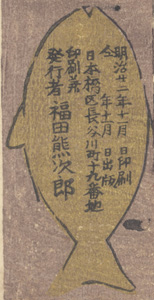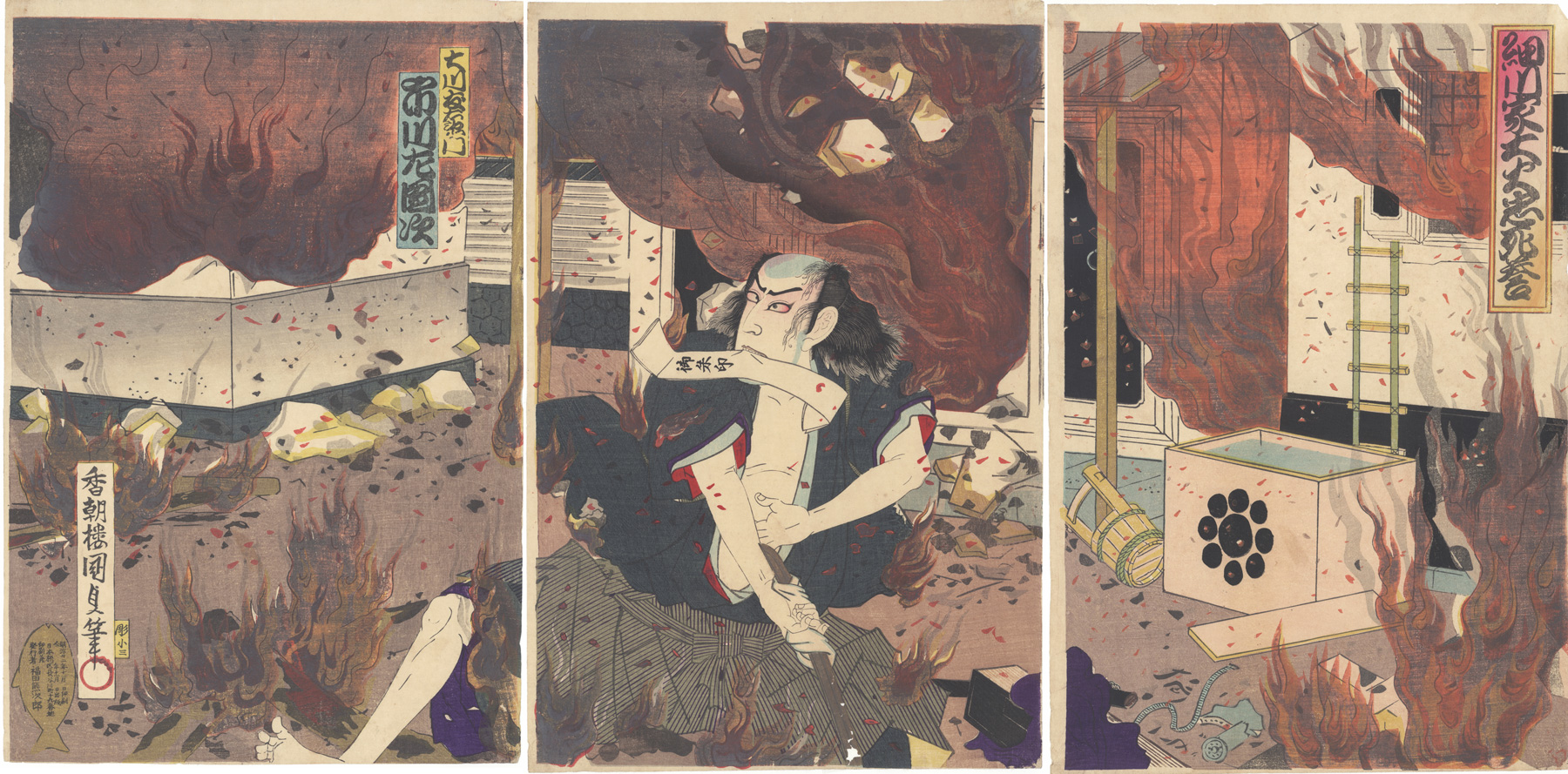The actor Ichikawa Sadanji 市川左団次 in the role of Okawa Tomoemon in the sensational act 4 "Tsuta moyō chizome no goshuin" of the play Hosokawa no chi-daruma. In this scene the hero Tomoemon, his clothes on fire, has just rescued the title deed to his master's, the daimyo Hosokawa's, fiefdom from the treasury room in Hosokawa's burning palace. Hemmed in by the fire and having no escape he is about to slit-open his belly and place the document inside to save it. The final scene will show Tomoemon's burnt corpse being carried before Hosokawa and the discovery that the deed, and therefore his master's fortune, has been saved, as the blood-stained document is drawn from Tomoemon's bosom.
The title deed clutched in Tomoemon's mouth in the print bears the characters 御朱印, goshuin, a letter bearing the shogun’s scarlet seal.
A review in The Japan Times of a November 1906 production of the same play, this time starring Ichikawa Sadanji's son, Ichikawa Sadanji II, describes the above scene as follows:
The curtain now rises on an extraordinary spectacle, the burning yashiki [palace]. The whole stage seems to be a sea of fire, and amid the rolling of smoke, the crash of falling roofs and the rush of flames, Okawa leaps into the conflagration. He forces open the red-hot iron door of a strong room, enters in search of the document, and finally emerges with it, his garments actually on fire. Escape however, is barred on every side, and it appears that the destruction of the document as well as of himself is inevitable, when a thought occurs to him. He draws his sword, cuts open his bosom and places the document inside his body.
The fire on the stage must be seen to be credited. One is perplexed to understand how these fierce flames fail to consume the whole theatre.1
[This last remark by the critic will prove to be prophetic, when in 1958 a theater was accidentally destroyed by using this device. Use of the device was subsequently banned.2]
The Fukiboya "Blow Fire"
This play, first staged at the Ichimura-za on November 10, 1889, used a newly invented device, the fukiboya, for creating the pyrotechnical effects. Its operation is described by Leiter in his New Kabuki Encyclopedia as follows:
Pocketheater fuel and pine needles were placed at the bottom of a lamp. Air was then blown into the lamp through atwo-foot pipe attached to a three inch-wide funnel containing a powderedmixture of pocket heater fuel and pine resin covered by a cloth dipped ingasoline. When it was lit and air wasblown through the pipe, the flaming powder – accompanied by black smoke – wouldrise, giving the impression of a conflagration.3
Pigment Oxidation
Note that the orange ink used to print the flames on this collection's impression has oxidized, resulting in flames that look very ash laden. It has been suggested that the use of this particular mercuric-based orange ink and its propensity to oxidize was intentional on some prints.4
The Actor Pictured
For background on the actor Ichikawa Sadanji see his profile in the article The Kabuki Actor on this site.1 The Japan Weekly Mail, No. 26 Vol. XLV Nov 24, 1906
2 New Kabuki Encyclopedia: A Revised Adaptation of Kabuki Jiten, Samuel Leiter, Greenwood Press, 1997, p. 99.
3 ibid.
4 Yoshitoshi's One Hundred Aspects of the Moon, John Stevenson, Hotei Publishing, Netherlands 2001, plate 39.
Print Details
| IHL Catalog | #1690 |
| Title (Description) | The Bloodstained Document of the Hosokawa's 細川家大火忠死誉 (as written in the multi-color cartouche upper right hand corner of right panel.) |
| Artist | Utagawa Kunimasa IV (1848-1920) |
| Signature |  |
| Seal | (年玉印 Toshidama seal beneath signature (see above) |
| Publication Date | November 1889 (Meiji 22) 明治廿二年十一月 日 |
| Publisher |  [Marks: seal not shown; pub. ref. 071] |
| Carver |  |
| Impression | excellent |
| Colors | excellent |
| Condition | good - three separate sheets with nearly full margins; not backed; heavy oxidation of orange pigment; toning; paper loss to center panel middle bottom area repaired verso |
| Genre | ukiyo-e; yakusha-e |
| Miscellaneous | |
| Format | vertical oban triptych |
| H x W Paper | right sheet:14 1/2 x 9 3/4 in. (36.8 x 24.8 cm) center sheet: 14 1/2 x 9 5/8 in. (36.8 x 24.4 cm) left sheet:14 3/8 x 9 3/4 in. (36.5 x 24.8 cm) |
| H x W Image | right sheet:14 x 9 7/16 in. (35.6 x 24 cm) center sheet: 14 x 9 7/16 in. (35.6 x 24 cm) left sheet:14 x 9 5/8 in. (35.6 x 24.4 cm) |
| Literature | |
| Collections This Print | The Tsubouchi Memorial Theatre Museum of Waseda University 100-6818, 6819, 6820; Art Research Center, Ritsumeikan University AcNo. shiUYa0091, shiUYa0092, shiUYa0093 |
8/22/2021
2/6/2020


